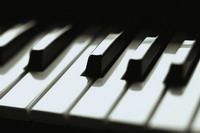Piano Sheets > Ben E. King Sheet Music > Stand By Me (ver. 7) Piano Sheet
Stand By Me (ver. 7) by Ben E. King - Piano Sheets and Free Sheet Music

About the Song
Other avaliable versions of this music sheet: Version 1 Version 5 Version 6 Version 7
"Stand by Me" is the title of a song performed by Ben E. King and written by Ben E. King, Jerry Leiber and Mike Stoller. The song is inspired by a traditional Gospel song of the same name, originally composed by Charles A. Tindley in 1905, and recorded by numerous artists, including a 1955 version by The Staple Singers. Leiber and Stoller gave it a more contemporary sound. Since its release, there have been many cover versions of the song, though none have achieved the fame of the original. Ben E. King (born Benjamin Earl Nelson on September 28; 1938; in Henderson; North Carolina) became a famous soul singer of the early 60-s. He is probably best known as the singer and co-composer of -Stand by Me;- a U.S. top 10 hit in both 1961 and 1987 and a #1 hit in the UK in 1987; and as one of the principal lead singers of the legendary R&B vocal group; The Drifters.Currently; King is active in his.
Download this sheet!
About the Artist

Random article
Sheet music, theory and beyond When you take a look at a piano music sheet for the first time, all you will see is beautiful written characters which make absolutely no sense to you. And if you are a keen observer, you will notice that there are many types of circles associated with the piano music sheet language. Sheet music belonging to the instrument piano also consists of incomplete circles connected together by one or a collection of lines. Plus there are other symbols which will appear totally strange to you. So what are they all about and what do they mean? (More...)
